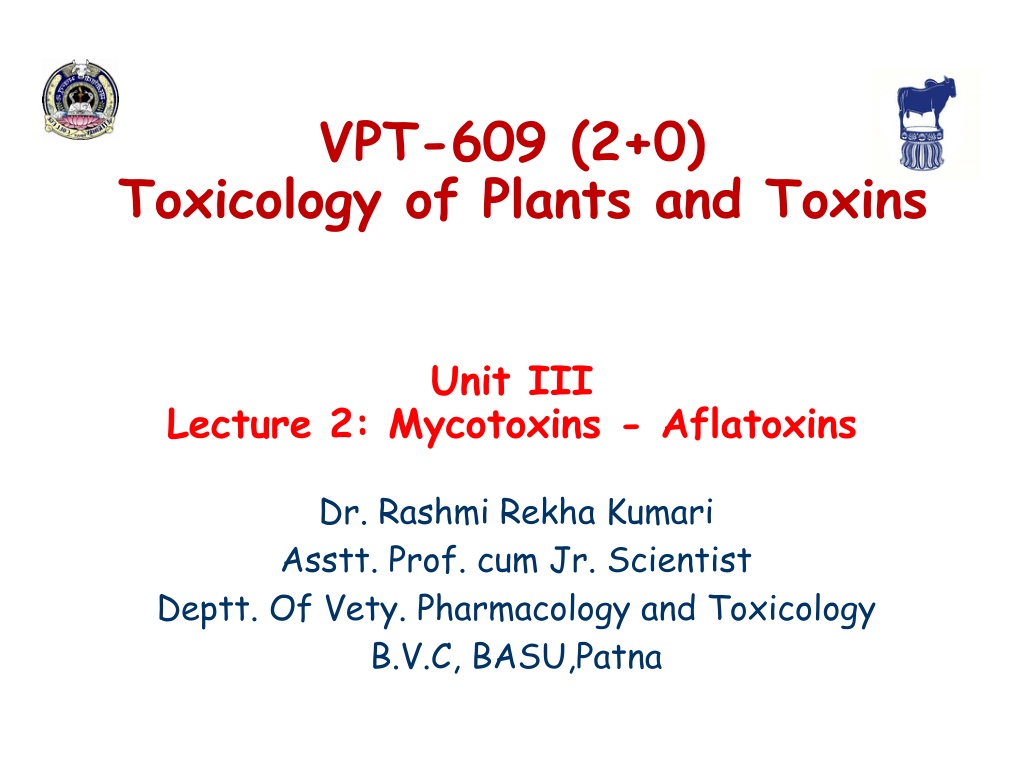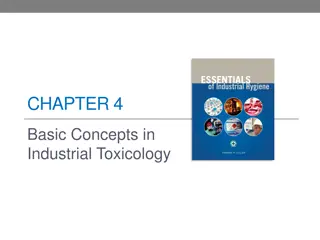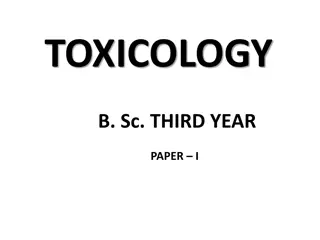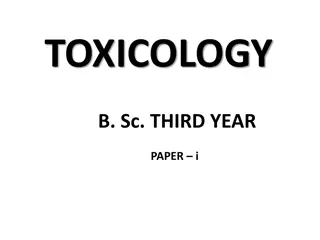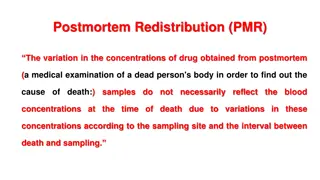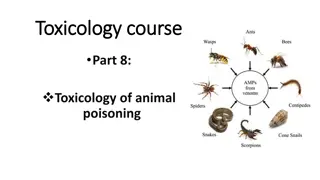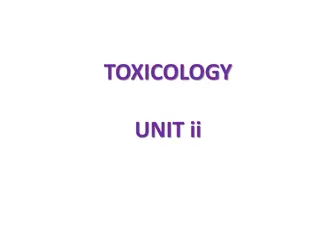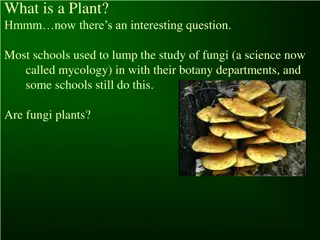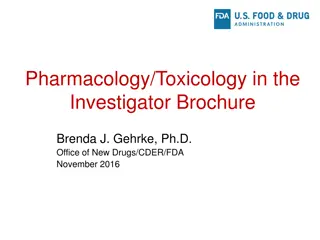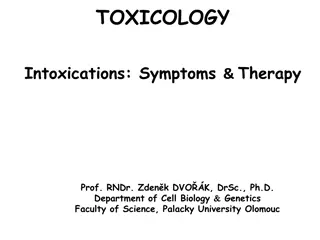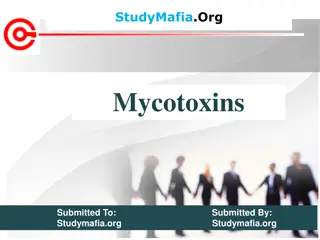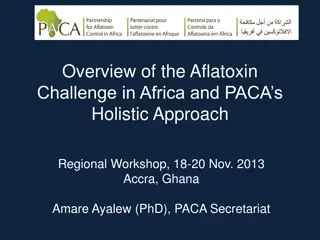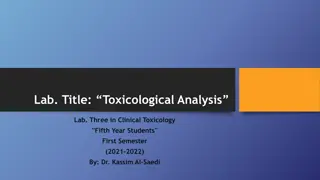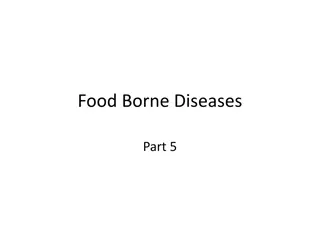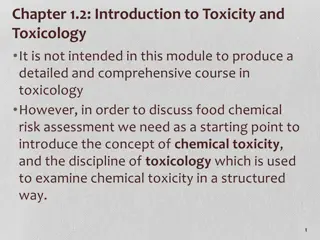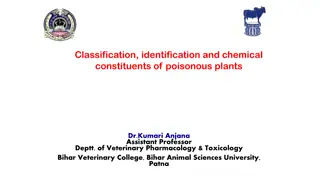Understanding Aflatoxins: Mycotoxins and Toxicology in Plants
Mycotoxicoses refers to illnesses in humans or animals caused by ingesting substances produced by certain molds or fungi on food. Aflatoxins are a type of mycotoxin that are potent mutagens, carcinogens, teratogens, and liver damage agents. They were first discovered in the 1960s and are known to be heat resistant and remain in feed for years. Aflatoxins can have serious biological effects by binding to DNA and inhibiting RNA synthesis. The toxicity of aflatoxins varies, with Aflatoxin B1 being the most concerning due to its common occurrence in food items and high toxicity. The mechanism of action involves binding to nuclear DNA and affecting the liver, carcinogenicity, mutagenicity, and immunosuppression.
Download Presentation

Please find below an Image/Link to download the presentation.
The content on the website is provided AS IS for your information and personal use only. It may not be sold, licensed, or shared on other websites without obtaining consent from the author. Download presentation by click this link. If you encounter any issues during the download, it is possible that the publisher has removed the file from their server.
E N D
Presentation Transcript
VPT-609 (2+0) Toxicology of Plants and Toxins Unit III Lecture 2: Mycotoxins - Aflatoxins Dr. Rashmi Rekha Kumari Asstt. Prof. cum Jr. Scientist Deptt. Of Vety. Pharmacology and Toxicology B.V.C, BASU,Patna
DEFINITION Mycotoxicoses is defined as an illness of man or animal due to ingestion of pre-formed substances produced by the action of certain molds or filamentous fungi on particular food- stuff. MYCOTOXINS Secondary metabolites produced by food-borne filamentous fungi Vary in their severity :Carcinogen/allergen Non-volatile & low molecular weight Some are lethal Cause identifiable diseases Weaken the immune system without producing symptoms
AFLATOXINS (Aflatoxicosis) These toxins were discovered as a cause of mysterious disease termed as Turkey-X-disease during 1960s in England. Killed approx.1,00,000 birds and ruined turkey industry Aflatoxins were first chemically isolated in 1962. Aflatoxins most commonly produced by A.flavus are B1 and B2. A.parasiticus produces G1and G2. These are designated as B & G on the basis of their metabolites which exhibits blue(B) and green(G) fluorescence under U.V. light on TLC plates. Aflatoxin B1 is the most important biologically active mycotoxin because of its common occurrence in food items and is highly toxic and carcinogenic. The order of Toxicity is B1>G1> B2>G2 These Toxins are relatively heat resistant and not soluble in water .
Aflatoxins are potent mutagen, carcinogens, teratogens and liver damage agent Toxins are heat resistant and remain in feed for year Hydroxylated metabolite of B1 and B2 aflatoxins are excreted in milk and are termed as M1 and M2 All species are susceptible Mechanism of action: All effect(hypatotoxicity, carcinogenicity, mutagenicity and immunosuppresants. All effect result from binding of AFB1 and its metabolite to nuclear DNA and inhibition of synthesis of RNA, enzyme and other protein.
Toxicokinetics B1 in excess of 100ug per kg of feed is toxic to cattle. Most of the ingested toxicant binds with ruminal content but only 2- 5% reaches intestine from where they are absorbed. In blood the toxins bind to the plasma protein. The liver removes most of the toxins from blood stream metabolised by cytochrome-P450 group of enzyme into different metabolites. Aflatoxin B1 is converted into aflatoxicol, AflatoxinP1, AflatoxinQ1, Aflatoxin M1. Along with these aflatoxin 8, 9, epoxide is formed which is highly reactive. Aflatoxin M1 is toxic, carcinogenic and is excreted in milk.
Mechanism of action Aflatoxins modify DNA template and interfere with function of DNA dependent RNA polymerase and m-RNA synthesis . Toxins also binds to endoplasmic steroidal ribosome binding site causing disaggregation of ribosomes. Interference with both transcription and translation. Formation of enzymes and other essential cellular macromolecules, clotting factors(prothrombin) etc is blocked leading to glycogen depletion, failure of energy metabolism Immunosuppressant , predisposes to secondary infection.
Impaired protein synthesis interferes with formation of structural proteins and enzymes necessary for various biochemical process. This lead to following effect Defective enzyme synthesis affects the energy and fat metabolism. Accumulation of fat and failure of transport mechanism of fat from liver result in excessive accumulation of fat in liver. Loss of enzyme result in reduced formation of structural proteins. Loss of tissue strength in blood vessels may lead to increased capillary permeability and bleeding. Defective enzyme and protein synthesis result in decreased prothrombin and other clotting factors synthesis in liver and decreased vitamin K activities. This action in combination with weak capillaries results in haemorrhagic phenomenon.
Defective enzyme may cause improper antibody formation and immunosuppressant Jaundice and decreased serum protein are synthesised by the liver. Binding of epoxide with DNA may lead to DNA breakage and chromosomal aberration.
Clinical Sign and necropsy Acute Toxicity: In acute outbreaks, deaths occur after a short period of inappetence; other acute signs include weakness, anorexia, vomiting, depression,dyspnoea, epistaxis, bloody faeces hemorrhage, and icterus, convulsion and death. Clinical sign in birds may include anorexia, ruffled feather, ataxia, circling, opisthtonus, convulsions, echymoses, oedema and rapid death.
Subacute Toxicity Are more usual, with unthriftiness, weakness, anorexia, reduced growth and feed efficiency, jaundice, hypoprothrombinnmia, haematomas and haemorrhagic enteritis (warfarin like condition) and occasional sudden deaths. In cattle, there may be blindness, moving in circle, ear twitching, teeth grinding, photosensitive dermatitis, ataxia etc.
Chronic disease Gradual reduction in feed efficiency, productivity and growth rate, rough hair coat, anaemia, enlarged abdomen and jaundice. Prolonged feeding of low concentrations of aflatoxins may result in diffuse liver fibrosis (cirrhosis) and, rarely, carcinoma of the bile ducts or liver.
Laboratory Investigation Laboratory changes in most species are related to liver damage, coagulopathy, and impaired protein synthesis. Specific laboratory changes include increased AST, ALT, and alkaline phosphatase; hypothrombinemia, prothrombin and activated partial thromboplastin times, hyperbilirubinemia, hypocholesterolemia, hypoalbuminemia, and Variable thrombocytopenia, elevated BUN, suppressed cell mediated and humoral immune response. Determination of aflatoxin in milk, meat and egg and metabolite in urine. prolonged
Treatment Withdrawal of contaminated feed at once. Low fat and high protein diet Multivitamins, Se and Vitamin E Anabolic steroid stanozolol @ 2mg/kg i/m at 4-5 day intervals. Activated charcoal @ 6.5 mg/kg intraruminally as 30% W/V slurry in phosphate buffer of pH 7 I/V 5% dextrose Hepatotonic Prevention: Hydrated sodium calcium aluminosilicate in feed at 0.5%( adsorb the toxin)
